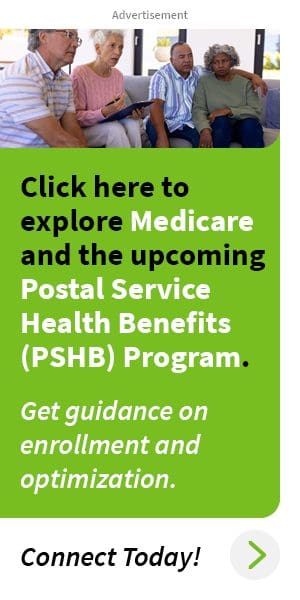Key Takeaways
-
The Postal Service Health Benefits (PSHB) Program is set to replace the Federal Employees Health Benefits (FEHB) Program for USPS employees and retirees in 2025. It’s important to understand the changes and how they may affect your coverage.
-
By planning ahead and taking advantage of Open Season, you can ensure a smooth transition to the new system without any interruptions in your healthcare benefits.
Understanding the PSHB Program: What’s Changing?
The PSHB Program, launching on January 1, 2025, is a postal-specific health benefits system created under the 2022 Postal Service Reform Act. It aims to streamline health benefits for USPS employees, retirees, and their eligible family members while reducing costs for the Postal Service.
Here are the key changes:
-
The PSHB Program will replace the FEHB Program for USPS workers and retirees.
-
Medicare integration becomes a requirement for many Medicare-eligible retirees and their dependents.
-
The program introduces health plans specifically tailored to meet the needs of postal workers and retirees.
Why This Transition Is Happening
The shift to the PSHB Program is designed to address USPS’s financial challenges while maintaining comprehensive health coverage for employees and retirees. It introduces Medicare integration for eligible retirees, ensuring:
-
Cost Efficiency: Aligning with Medicare reduces overall healthcare costs for retirees and the Postal Service.
-
Tailored Benefits: Plans are designed to better serve the postal workforce.
-
Sustainability: The new system aims to enhance USPS’s financial stability in the long term.
Key Dates You Need to Know
To prepare for this significant transition, keep these dates in mind:
-
Open Season: November 11 to December 9, 2024. This is your opportunity to select or confirm your PSHB plan for 2025.
-
Medicare Part B Enrollment Deadline: For Medicare-eligible retirees, enrollment in Part B must be completed before January 1, 2025.
-
Effective Date: The PSHB Program officially replaces the FEHB Program on January 1, 2025.
Mark your calendar to avoid missing any critical deadlines.
What This Means for USPS Employees and Retirees
Current Employees
If you’re a USPS employee enrolled in the FEHB Program, your health coverage will automatically transition to a comparable PSHB plan. However, Open Season provides an opportunity to review your options and make changes if needed.
Medicare-Eligible Retirees
One of the most significant changes is the mandatory integration of Medicare Part B for eligible retirees. If you fall into this category, you’ll need to enroll in Part B to maintain your PSHB coverage. The standard monthly premium for Medicare Part B in 2025 is $185, with an annual deductible of $257.
Non-Medicare-Eligible Retirees
If you’re not eligible for Medicare, your transition to PSHB will still ensure comprehensive health benefits. Review your plan options during Open Season to confirm the best fit for your needs.
How Medicare and PSHB Work Together
For Medicare-eligible retirees, the integration of Medicare Part B with PSHB is designed to simplify and enhance healthcare coverage. Here’s how the two systems coordinate:
-
Primary and Secondary Payers: Medicare serves as the primary payer for most medical expenses, while PSHB acts as the secondary payer, covering additional costs like copayments and deductibles.
-
Lower Out-of-Pocket Costs: The combined coverage reduces your overall healthcare expenses.
-
Streamlined Benefits: You’ll have access to a broader range of services with minimal overlap.
Steps to Take Before Open Season
Preparation is key to navigating this transition smoothly. Here’s what you need to do:
1. Understand Your Eligibility
Determine if you’re required to enroll in Medicare Part B. Retirees who qualify for Medicare must enroll to maintain PSHB coverage unless exempt.
2. Review Your Current Health Plan
Compare your FEHB plan’s benefits to the new PSHB options. While you’ll be automatically enrolled in a comparable plan, it’s worth ensuring it meets your health and financial needs.
3. Attend USPS Informational Sessions
Take advantage of webinars and resources offered by USPS and the Office of Personnel Management (OPM) to gain a clearer understanding of the new system.
4. Budget for Medicare Part B
Include Medicare Part B premiums and deductibles in your financial planning to avoid surprises. For many, this will be an additional monthly cost.
What to Expect During Open Season
Open Season (November 11 to December 9, 2024) is your chance to:
-
Review plan options under the PSHB Program.
-
Confirm your Medicare Part B enrollment if required.
-
Make changes to your plan selection based on your healthcare needs.
Be proactive. Use this time to ensure you’re selecting the best plan for you and your family.
Common Questions About the Transition
Will My Coverage Change?
Your coverage may see minor adjustments, but the goal is to maintain continuity while tailoring plans to USPS employees and retirees. Automatic enrollment ensures you won’t face a gap in coverage.
What If I Don’t Enroll in Medicare Part B?
Failing to enroll in Part B if required could result in the loss of your PSHB coverage. Don’t risk it—enroll early.
Can I Keep My Current Doctors?
Most PSHB plans will have networks similar to FEHB plans. However, it’s always a good idea to verify that your preferred healthcare providers are included.
How PSHB Differs from FEHB
While the PSHB and FEHB programs share similarities, there are notable differences:
-
Postal-Specific Coverage: PSHB plans are tailored to the needs of USPS employees and retirees.
-
Medicare Integration: PSHB works seamlessly with Medicare to provide comprehensive coverage for eligible retirees.
-
Cost Efficiency: The new program is designed to lower overall costs for the Postal Service and its members.
Life After 2025: What to Expect
Once the PSHB Program is in place, you can look forward to:
-
Annual Open Seasons: Regular opportunities to review and adjust your coverage.
-
Ongoing Medicare Coordination: For eligible retirees, the integration of Medicare and PSHB will simplify healthcare management.
-
Enhanced Support: USPS and OPM will continue to provide resources to help you navigate your benefits.
Tips for a Smooth Transition
-
Start Early: Begin reviewing your options and preparing for Open Season as soon as possible.
-
Ask Questions: Don’t hesitate to reach out to USPS HR or attend informational sessions if you need clarification.
-
Stay Organized: Keep track of deadlines and ensure you have all necessary documents ready.
-
Plan Financially: Include Medicare Part B premiums and PSHB costs in your budget to avoid surprises.
Moving Forward with Confidence
The transition to the Postal Service Health Benefits Program represents a significant change, but it’s also an opportunity to optimize your health coverage. By staying informed, preparing for Open Season, and understanding how the new program works, you can navigate this shift with ease. Make sure to act early, ask questions, and choose a plan that best suits your needs. Your proactive approach will ensure you and your family have comprehensive and reliable healthcare in 2025 and beyond.











